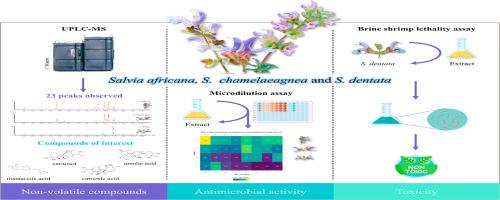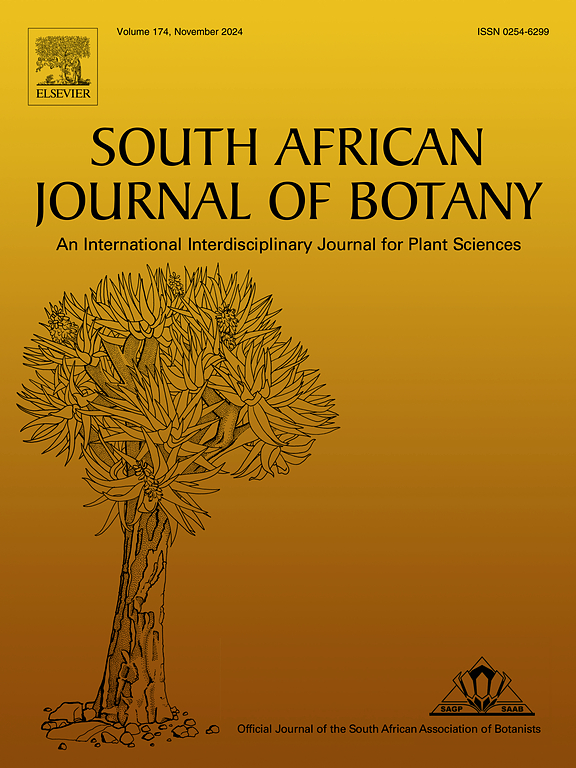三种南非鼠尾草在开普草药中的化学变异、抗菌活性和毒性
IF 2.7
3区 生物学
Q2 PLANT SCIENCES
引用次数: 0
摘要
鼠尾草是Lamiaceae中最大的属,包括许多具有药用和药理价值的物种。在南非,三种开蓝色花的物种被用于开普草药,但齿状花仍未得到充分研究。本研究对这三种植物的酚类成分进行了分析和比较,并对其抗菌活性和毒性进行了评价。酚类化合物用UHPLC-MS鉴定,鼠尾草酸和鼠尾草醇经NMR鉴定。UHPLC-MS分析显示,齿形参具有独特的化学特征,其特征为高水平的迷迭香酸(7)、乙酰鼠尾草酸(13)、表rosmanol甲基醚(16)、鼠尾草醇(14)和鼠尾草酸(18),与地中海迷迭香(S. rosmarinus)的特征非常相似。用微孔肉汤稀释法测定其抑菌活性,用盐水对虾致死法测定其毒性。牙参有机提取物的抑菌活性显著,对化脓性链球菌和粪肠球菌的MIC分别为0.13 mg/mL和0.15 mg/mL,对金黄色葡萄球菌、单核增生李斯特菌和无乳链球菌的MIC分别为0.57 mg/mL、0.25 mg/mL和0.23 mg/mL,抑菌活性中等。鼠尾草提取物无毒。在研究的三个物种中,齿状霉作为抗感染剂表现出最大的希望。然而,这种活性并不仅仅归因于鼠尾草酸或鼠尾草醇,这表明酚类物质之间存在协同作用。UHPLC-MS的应用是揭示齿形参独特化学特征的关键,特别是其与迷迭香的相似性,这是一个重要的新见解,扩大了齿形参在开普草药中的传统作用之外的潜在用途。本文章由计算机程序翻译,如有差异,请以英文原文为准。

Chemical variation, antimicrobial activity and toxicity of three South African species of Salvia used in Cape Herbal Medicine
Salvia is the largest genus in Lamiaceae and includes many species of medicinal and pharmacological value. In South Africa, three blue-flowered species are used in Cape Herbal Medicine, yet S. dentata remains poorly studied. This study profiles and compares the phenolic composition of these three species and evaluates the antimicrobial activity and toxicity of S. dentata. Phenolic compounds were identified using UHPLC-MS, with carnosic acid and carnosol confirmed by NMR. The UHPLC-MS analysis revealed a distinct chemical profile for S. dentata, marked by high levels of rosmarinic acid (7), acetoxycarnosic acid (13), epirosmanol methyl ether (16), carnosol (14), and carnosic acid (18), closely resembling the profile of Mediterranean rosemary (S. rosmarinus). Antimicrobial activity was assessed using the microwell broth dilution assay, and toxicity by the brine shrimp lethality assay. Organic extracts of S. dentata showed notable antimicrobial activity, with MIC values of 0.13 mg/mL (against Streptococcus pyogenes) and 0.15 mg/mL (Enterococcus faecium), and moderate activity against Staphylococcus aureus, Listeria monocytogenes and Streptococcus agalactiae (MIC values of 0.57 mg/mL, 0.25 mg/mL and 0.23 mg/mL respectively). The extract of Salvia dentata was noted to be non-toxic. Out of the three species studied, S. dentata demonstrated the greatest promise as an anti-infective agent. However, the activity is not solely attributed to carnosic acid or carnosol, suggesting synergistic interactions between phenolics. The application of UHPLC-MS was key to revealing the distinct chemical profile of S. dentata, particularly its strong similarity to S. rosmarinus, an important new insight that expands the potential use of S. dentata beyond the traditional role in Cape Herbal Medicine.
求助全文
通过发布文献求助,成功后即可免费获取论文全文。
去求助
来源期刊

South African Journal of Botany
生物-植物科学
CiteScore
5.20
自引率
9.70%
发文量
709
审稿时长
61 days
期刊介绍:
The South African Journal of Botany publishes original papers that deal with the classification, biodiversity, morphology, physiology, molecular biology, ecology, biotechnology, ethnobotany and other botanically related aspects of species that are of importance to southern Africa. Manuscripts dealing with significant new findings on other species of the world and general botanical principles will also be considered and are encouraged.
 求助内容:
求助内容: 应助结果提醒方式:
应助结果提醒方式:


